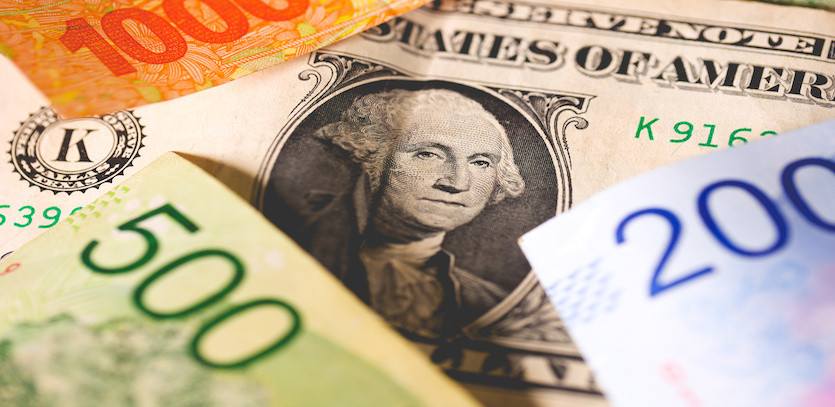The Influence of a Robust Dollar
Recently, the strength of the U.S. dollar has been making headlines. Various American enterprises have pointed to a robust dollar as a factor affecting their revenue performance, while economic analysts indicate that it's aiding the Federal Reserve's sustained battle against escalating inflation.
However, the question remains, how can one gauge if the dollar is weak or strong? That's where the U.S. Dollar Index (USDX) comes in, providing investors with insights into the dollar's potency. This vital index elucidates how fluctuations in the dollar's value affect consumer expenditure, the trade balance, and the overall economic landscape.
The Essence of the U.S. Dollar Index
The U.S. Dollar Index is a significant market yardstick that gauges the worth of the U.S. dollar compared to an assortment of globally traded currencies.
The Federal Reserve inaugurated the dollar index in 1973 to monitor the U.S. dollar's fluctuating value. This was following President Richard Nixon's decision in 1971 to dissociate from the gold standard, facilitating the dollar's free movement in foreign exchange markets. Since 1985, the dollar index has been computed and managed by the Intercontinental Exchange (ICE).
The Equation Behind the Dollar Index
The calculation of the U.S. Dollar Index entails a comparison of the dollar's value against a collection of foreign currencies. The initial selection encompassed the Japanese yen, British pound, Canadian dollar, Swedish krona, Swiss franc, and several European currencies.
USDX = 50.14348112 × EURUSD^-0.576 × USDJPY^0.136 × GBPUSD^-0.119 × USDCAD^0.091 × USDSEK^0.042 × USDCHF^0.036
Post the introduction of the euro in 1999, the currency selection was condensed, and the dollar index equation was modified. Presently, the mix comprises six currencies only: the euro (EUR), Japanese yen (JPY), British pound (GBP), Canadian dollar (CAD), Swedish krona (SEK), and Swiss franc (CHF).
ICE employs a specific equation to compute the value of the USDX, which fluctuated from a high of 163.83 in March 1985 to a low of 71.58 in April 2008. The euro represents the largest portion of the index, making up 57.6% of the mix. The shares of the other currencies are JPY (13.6%), GBP (11.9%), CAD (9.1%), SEK (4.2%), and CHF (3.6%).
Applications of the U.S. Dollar Index
The USDX facilitates traders and investors in keeping track of the U.S. dollar's purchasing power in relation to the six currencies within the index's basket.
Investors utilize the dollar index as a barometer for U.S. economic health, primarily regarding imports and exports. Increased U.S. exports result in heightened international demand for U.S. dollars to buy these goods, leading to a rise in the USDX.
Asher Rogovy, CIO at Magnifina, points out certain limitations of the USDX that investors should consider. The composition of the currencies utilized in the index is based on the U.S.'s main trading allies in the 1970s. Hence, the index doesn’t account for emerging market currencies or the Chinese renminbi (CNY), despite China being the U.S.'s primary trading partner today. Consequently, the index may not be as effective an economic indicator as in the past.
Factors Strengthening the U.S. Dollar
Over the past year, the USDX has surged 17.3% from approximately 94 to above 110. John Lynch, CIO at Comerica Wealth Management, attributes this rapid dollar strengthening in 2022 to various factors that present significant challenges for investors and central banks worldwide.
"A confluence of soaring inflation, the Fed's assertive tightening strategy, and a worldwide quest for yield have all fueled the robust dollar," explains Lynch.
A robust dollar implies relative weakness in global currencies, which, according to Lynch, intensifies inflationary pressures and market volatility. He believes that without a weakening of dollar strength, a lasting recovery in global risk assets is unlikely.
The Federal Reserve's foremost priority in 2022 has been curbing inflation, which is at its highest in decades, by implementing an increase in interest rates. The federal funds rate has already been raised to between 3% and 3.25%, with the Federal Open Market Committee issuing three consecutive significant rate hikes of 75 basis points.
These higher interest rates incite foreign investors to demand more U.S. dollars, adding upward pressure on the USDX. Concurrently, the geopolitical turmoil caused by Russia's invasion of Ukraine has generated economic uncertainty globally, particularly in Europe's energy sector. Given the U.S. dollar's status as the world's reserve currency and a safe haven during economically turbulent times, investors have been flocking to the dollar for protection and stability.
The Implications of a Robust Dollar
William Bevins, a private wealth manager at Cypress Capital, cautions that a robust dollar can negatively impact U.S. stocks generating international revenue. "Currency conversion can either enhance or hamper operating outcomes. Currently, the elevated dollar index could impede the overseas business of U.S. corporations," Bevins warns.
Goldman Sachs approximates that S&P 500 companies generate around 29% of their total revenue from outside the U.S. Consequently, analysts have reduced S&P 500 revenue growth estimates for 2023. Tech stocks, particularly vulnerable, derive 59% of their total sales from international markets, according to Goldman Sachs. Prominent tech and non-tech companies with significant overseas revenue could face headwinds due to the robust dollar in the upcoming quarters.
Investing in the Dollar Index
Investors interested in trading the U.S. Dollar Index have several options.
Professionals often use futures and options contracts for dollar index investments. ICE provides dollar index futures for trading nearly around the clock on their platform, with six different USDX options contracts, each with a unique expiration date from one month to a year in the future. However, traders must fully comprehend these derivative contracts and the associated risks before engaging.
Additionally, several popular exchange-traded funds (ETFs) track the USDX. The Invesco DB US Dollar Index Bullish (UUP) invests in U.S. Dollar Index futures contracts. This fund is liquid and manages over $2 billion in assets, with an average daily trading volume exceeding 4.1 million shares. Other options include leveraged currency ETFs to wager against weakening international currencies.
In conclusion, understanding the U.S. Dollar Index is crucial for grasping the dynamics of the global economic landscape. The USDX serves as a barometer of the U.S. dollar's strength against a basket of major world currencies, influencing consumer prices, international trade, and the overall economic climate. While a strong dollar can present challenges for U.S. companies with substantial overseas revenue, it also opens up unique investment opportunities for savvy investors.
The influence of the USDX goes beyond mere numbers. It impacts business decisions, affects the profitability of multinational companies, and can even dictate the monetary policies of central banks around the world. Thus, comprehending the Dollar Index and the factors that influence it is an invaluable tool for investors and policymakers alike. With the right knowledge and strategies, stakeholders can navigate the economic implications of a fluctuating U.S. dollar and leverage them to their advantage.





